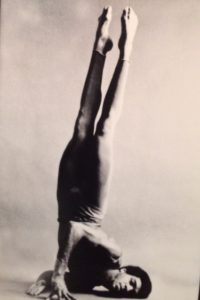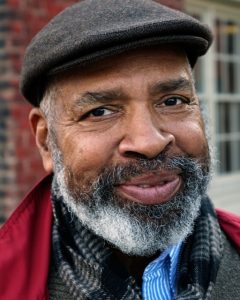By Page H. Gifford
Correspondent
 It has been over ten years since The Fluvanna Arts Council featured dance performances at Carysbrook Performing Arts Center and this included one night of modern dance and Irish steppers with musical groups like Iona. Whether dance will ever draw crowds or become a staple of Carysbrook’s future schedule, remains to be seen.
It has been over ten years since The Fluvanna Arts Council featured dance performances at Carysbrook Performing Arts Center and this included one night of modern dance and Irish steppers with musical groups like Iona. Whether dance will ever draw crowds or become a staple of Carysbrook’s future schedule, remains to be seen.
But in an attempt to bring diversity in performances, other than just music and theater, FCAC partnered with Charlottesville Ballet to present “Breaking Barriers: Celebrating Keith Lee and 50 Years of Dance & Theater.” The film is Keith Lee’s newest piece, “And the VIII Journey,” performed at the historic Academy Center of the Arts in Lynchburg. The event featured a screening of their mini-documentary celebrating Lee and his 50 plus year career in the arts. There was also a panel discussion with key figures from the documentary. The world premiere of the video was on May 2, but can still be viewed on-demand through June 1 at https://www.charlottesvilleballet.org.
Keith Lee–artist laureate, resident choreographer, and director of diversity & inclusion–is a master teacher and choreographer who has had a long and prestigious career. As a kid growing up in Bronx, New York, he trained at the High School of Performing Arts in NYC. In 1969 Lee joined American Ballet Theatre and was promoted to the rank of soloist the following year. He then pursued his career at Alvin Ailey American Dance Theater as their ballet master. He has choreographed works for American Ballet Theater, the Washington Ballet, the Geneva Ballet, the Oakland Ballet, the Garden State Ballet, Alvin Ailey Repertory Ensemble, the Lexington Ballet, and the Charlottesville Ballet. Lee continues to work as a freelance choreographer, teacher, and performing arts coordinator.
 Lee’s vision is seen in the strength of his work and the story he tells through movement. He combines ballet with modern dance for a stunning experience. His choreography is fluid, punctuated by striking moves similar to a crescendo in music.
Lee’s vision is seen in the strength of his work and the story he tells through movement. He combines ballet with modern dance for a stunning experience. His choreography is fluid, punctuated by striking moves similar to a crescendo in music.
“Keith has been working with the Charlottesville Ballet since 2008, first as associate director in the early days then as a guest choreographer then with his title of artist laureate.
“While he’s always created inclusive works of art that inspire our audiences, his new administrative role is more hands-on so that he can oversee our access and inclusion efforts at all levels of the Ballet as an institution,” said Emily Hartka, co-founder of Charlottesville Ballet. She adds the currently he has worked with their board of directors on DEI strategy, including facilitating discussions and training with the Center for Nonprofit Excellence. He is working one-on-one coaching our Charlottesville Ballet Academy faculty and teaching students each week while engaging with stakeholders from their Charlottesville Ballet Moves community engagement programs, including Chance To Dance and the Movement for Parkinson’s program. Hartka adds that the oversight and direction from Lee are key to continuing their inclusion efforts and having accountability to keep pushing forward.
Dominated for centuries by the French and Russians; ballet was viewed as an elitist form of dance, enjoyed only by those who could afford and appreciate it. Only those who were immensely talented and brilliant curried favor with the ballet master and were able to withstand the rigorous discipline that ballet required. Icons like Pavlova, Balanchine, Nureyev, and Baryshnikov were among the favored.
Hartka said that when she and Sara Clayborne founded CB 13 years ago, they knew that the world of classical ballet could be better and they had a vision to create a company that would not discriminate against people; specifically dancers based on their shade, size, or shape.
In America, ballet emerged in a new age with American cultural influences, breaking barriers with soloist dancers like Keith Lee, companies like Alvin Ailey, and prima ballerinas like Misty Copeland. Ballet has become the foundation for dance like classical music has become the foundation for all music. It is the framework, the discipline, and what gives dance its grace and beauty in movement.
“To us, diversity has a broader definition than just race, especially in classical ballet, there are biases for socioeconomic backgrounds and genders and body types and physical abilities. Ballet is still perceived as a predominantly white, upper-middle-class activity for little girls who can jump and twirl around in a tutu. That’s great, but not at all the scope of what dance can be and who it can serve,” she said. “We want to put processes and programs in place to change these perceptions and make our dancers, students, and patrons feel not only ‘welcomed’ but feel a sense of true belonging. This art form is for everyone – no matter where you come from, what language you speak, or what your age or ability is. Everybody can dance.”
She believes that at the professional level and especially at the historic dance institutions, leaders are finally having conversations about “aesthetics” and acknowledging the bias that is inherent in the classical ballet tradition. Hartka is honest in her appraisal of the current ballet environment. “I would love to see more people of color in companies and dance schools, however, these are elite athletes, and the resource commitment to getting a person from a young child studying dance to a professional athlete is pretty insane. For lots of institutions and even for some internally here at the Ballet, there may be a sense of “otherness” felt by dancers or patrons of color.”
She adds that representation matters, whether it’s watching company artists from across the U.S. and the world, or taking classes with students of all backgrounds at the Academy, or coming to a sensory-friendly show, or taking a Movement for Parkinson’s class.
Hartka, Lee, and the vision of the Fluvanna Arts Council, encompasses all those who wish to participate and not just those who can afford to. Hartka admits she was unaware of how many lives they would be able to touch with our mission of wellness and access and inclusivity. FCAC looks at the same question, knowing that access and participation in the arts enriches and educates all of us.
“Especially after the riots in Charlottesville and the events of 2020, I realized that Charlottesville Ballet can and must step into our role as a community-driven organization, even if I am worried about being inauthentic or making people uncomfortable because doing this work and educating and trying to grow is never comfortable,” said Hartka. “The arts are a vehicle for us to come together and to tell stories and to truly see people as humans, which is something we all so desperately need.”




